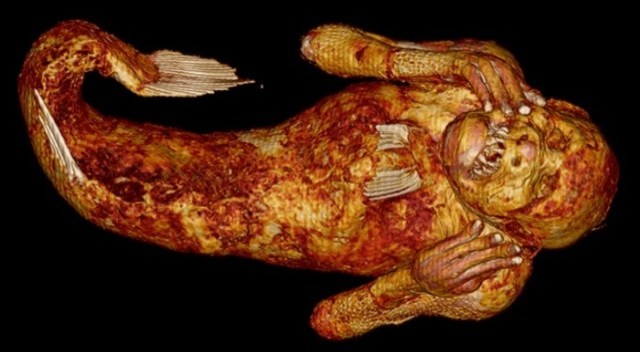Mermaid mummy stored at Japanese temple has true identity revealed after year-long study【Video】

Ningyo was said to have been pulled out of the sea by a fisherman in Tosa domain nearly 300 years ago.
Much like how the dragons of Japanese lore differ from their European counterparts, Japanese mermaids look very different from what you you’ll see in a Hans Christian Andersen storybook or Disney movie. Japan’s ningyo (which translates literally as “people fish”) are often depicted not with the upper body of a supermodel, but a more compact, almost simian form.
If you’re having trouble forming a mental image, perhaps this video will help and/or give you nightmares.
Shown in the video is one of the treasures stored at Enjuin Temple in the town of Asakuchi, Okayama Prefecture. According to a handwritten note inside the paulownia box in which it’s been stored, it’s the mummified body of a ningyo that was caught in a fisherman’s net in the waters off Tosa (present-day Kochi Prefecture) during the Genbun era of Japanese history, which lasted from 1736 to 1741.
▼ Enjuin’s mermaid mummy

However, no one is exactly sure how the temple came to be in possession of the mermaid mummy, which doesn’t exactly help the tale’s plausibility. In February of last year a five-person team of researchers from Kurashiki University of Science and the Arts, also in Okayama, began an investigation to determine the true identity of the artifact through X-rays, CT scans, DNA analysis, and radiocarbon dating.
ツイートが遅れましたが2022年2/2〜倉敷芸術科学大学が調査していた円珠院 #人魚のミイラ の研究中間報告が発表されています。併せてお知らせのように7/16〜9/25倉敷市立自然史博物館で展示します。
— パオちゃん(倉敷市立自然史博物館) (@kura_n_h_museum) April 8, 2022
円珠院所蔵「人魚のミイラ」研究中間報告(2022.04.04) | 倉敷芸術科学大学https://t.co/yTIcvyWxkS pic.twitter.com/nA9DFOno6s
This week the team announced its results, and unfortunately for cryptid fans, no, it turns out it’s not actually a mermaid. The KUSA team knew something was up when the only genuine skeletal structure component they could confirm was a jawbone, as the 30-centimeter (11.8-inch) “ningyo” lacked a skull, spine, or ribs.
Instead, the investigation found that the artifact was crafted from a plaster or gypsum-like substance, from which features including its arms, hands, and eye sockets were formed. The upper body, which also had portions made of cloth, was wrapped in a thin sheet of paper, which was then wrapped in fugu (blowfish) skin, and the head was stuffed with cotton with some sort of indeterminate animal hair attached to the top of the head to give it a mammalian appearance. The scales and fins on the lower body, meanwhile, appear to be from a species of croaker fish. Even the part about the artifact being found in a fisherman’s net circa 1740 appears to be a hoax, as the researchers, after examining some scales that fell off of the lower-body portion, calculated that the ningyo carcass was most likely from the latter half of the 1800s.
However, the temple isn’t upset about having been duped. Speaking after the researchers announced their results, Enjuin abbot Hiroyoshi Kuida said “I think, because of the tale, many people have come to see the ningyo [when it is on display], and prayed while they are here, and I think they’ll continue to do so,” adding, “Knowing that it was made from living things, we will continue to take good care of it and keep it safe.”
▼ Hiroyoshi Kuida can be seen in this clip
It’s worth pointing out that ningyo aren’t prescribed any special religious significance in Japanese Buddhism, so the revelation that Enjuin’s isn’t real is unlikely to trigger any crises of faith or drop in visitors to the temple.
Sources: Asahi Shimbun via Livedoor News via Hachima Kiko, Kurashiki University of Science and the Arts, @Press
Top image: Pakutaso
Insert image: @Press
● Want to hear about SoraNews24’s latest articles as soon as they’re published? Follow us on Facebook and Twitter!
Credit:

0 comments: